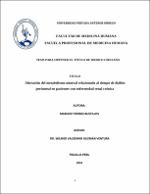Alteración del metabolismo mineral relacionado al tiempo de diálisis peritoneal en pacientes con enfermedad renal crónica

Ver/
Descargar
(application/pdf: 496.4Kb)
(application/pdf: 496.4Kb)
Fecha
2018Autor(es)
Toribio Bustillos, Marleni
Metadatos
Mostrar el registro completo del ítemResumen
OBJETIVO: Nos propusimos determinar la relación que existe entre alteraciones de
metabolismo mineral en relación al tiempo de diálisis peritoneal de pacientes con enfermedad
renal crónica.
MATERIAL Y MÉTODO: Es un estudio de cohorte retrospectivo. La población estuvo
constituida por 182 pacientes con enfermedad renal crónica dividida en dos grupos: 91
pacientes con enfermedad renal crónica en programa de diálisis peritoneal y 91 pacientes con
enfermedad renal crónica en estadio 4 y 5 y sin diálisis peritoneal; se calculó el RR y la
prueba T student.
RESULTADOS: De los 91 pacientes en diálisis peritoneal la edad promedio fue de 64,4
±10,85 y de los 91 pacientes con enfermedad renal crónico fue de 64,8 ± 12,43 años. Se
encontró que los pacientes en diálisis peritoneal tienen un riesgo relativo mayor de padecer
alteraciones del metabolismo mineral que los pacientes que no se encuentran en diálisis. El
riesgo de tener alteraciones del calcio es 2.14 veces más, alteraciones del fósforo 2.33 veces
más y alteraciones de la paratohormona 1.91 veces más, todas estas diferencias fueron
significativas. El riesgo de tener estas alteraciones aumenta con el tiempo que permanecen
en diálisis peritoneal.
CONCLUSIÓN: La diálisis peritoneal incrementa el riesgo de tener complicaciones del
metabolismo mineral y el tiempo de permanencia en diálisis incrementa este riesgo. OBJECTIVE: We aimed to determine the relationship between the alteration of the
mineral metabolism in relation to the time of peritoneal dialysis of patients with
chronic kidney disease.
MATERIAL AND METHODS: It is a retrospective cohort study. The population
consisted of 182 patients with chronic kidney disease divided into two groups: 91
patients with chronic kidney disease on peritoneal dialysis program and 91 patients
with chronic kidney disease at stage 4 and 5 and without peritoneal dialysis; the RR
and the T student test were calculated.
RESULTS: Of the 91 patients on peritoneal dialysis, the average age was 64.4 ±
10.85 and of the 91 patients with chronic kidney disease it was 64.8 ± 12.43 years.
It was found that patients on peritoneal dialysis have a higher relative risk of suffering
from mineral metabolism alterations than patients who are not on dialysis. The risk
of having calcium alterations is 2.14 times more, alterations of phosphorus 2.33
times more and alterations of the paratohormone 1.91 times more, all these
differences were significant. The risk of having these alterations increases with the
time they remain on peritoneal dialysis.
CONCLUSIONS: Peritoneal dialysis increases the risk of complications of mineral
metabolism and the time spent on dialysis increases this risk.
Palabras clave
Colecciones
- Medicina Humana [3196]

